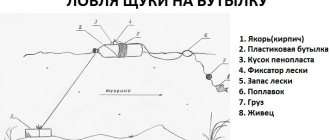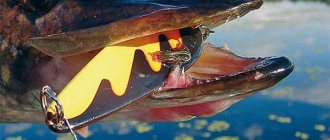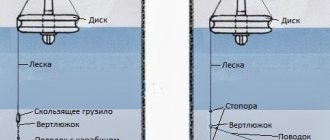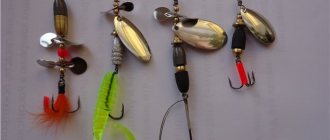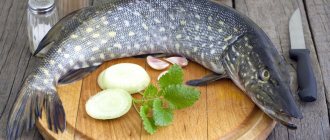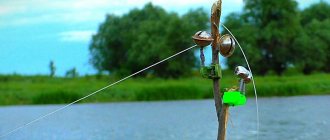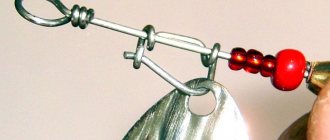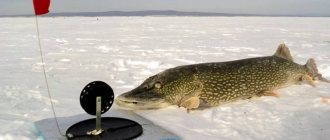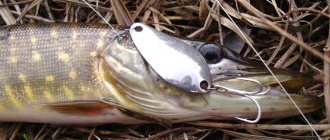How should you handle a pike to cause minimal injury to it?
There is quite a lot of debate about this issue, some believe that it is better to take it by the gills, some take it by the eyes, some take it with a glove. Which method is more humane for fish, because we need to preach the “catch and release” principle so that our children and grandchildren have someone to go fishing with. So, most anglers who want to beautifully photograph a caught pike take it by the eyes, brushing its teeth or thinking that this will not injure the pike, but in fact this is very harmful to it, especially if the pike is large.
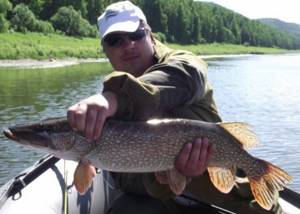
Moreover, it is not recommended to hold the pike vertically, as this creates a load on its spine, because it is constantly in a horizontal position in the water.
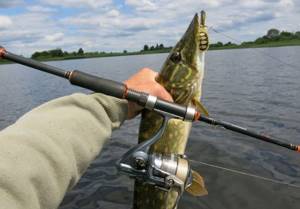
Fishing protective gloves

There are also special fishing gloves that can protect the fisherman's hand from sharp pike teeth, fins and gill covers. High-quality protective gloves are made from the strongest material - Kevlar, but not all gloves can boast of it. A medium-sized pike can be taken by the lower jaw without fear of being bitten, but specimens over two kilograms are best taken carefully by the gills.
For a more detailed review of protective gloves, see here.
How to take a pike: instructions

Any angler wants to capture his trophy in a photo, so that later he will have something to remember and show to his friends. Unfortunately, often in fishing photos you can see a terribly unaesthetic picture: a fisherman holding a bleeding pike by the eyes. Why do this?! 

To understand the problem, I conducted my own research. Here are the opinions we heard:
We are strictly against fishermen who hold pike (or any other fish) by the eyes! Your heart swells when you look at this sight! If I see such photos on blogs, I give them a low rating. I believe that any conscientious fisherman is obliged to treat fish humanely. Is there a need to take a pike by the eyes? I don’t understand who came up with the idea of grabbing fish like that? In European countries they don't do this . Believe me, it’s just as easy to grab hold of the gills, and the fish will suffer less.
Fish is a living creature. If you are going to eat a pike, then put it on a kukan or stun it with a mallet to kill it immediately. I think the tradition of “grabbing by the eyes” is, first of all, a way to conveniently and securely grab a pike, and given that the “catch and release” principle is developed only among athletes, then what kind of humanity can we talk about? It's a pity.
Don't treat your trophy like a piece of meat! Fishermen are not butchers . Is it difficult to take a large pike by the gills? Have you tried it?! For the sake of a photo where the “hero” is holding a fish squirming in pain, you are ready to disregard all norms. You can not do it this way!
How to take a pike correctly?
For the gills
The easiest way. It does not require additional accessories. Just practice! After practicing on small grass pike, you will confidently take 5-6 kg of mothers 

Landing net
It is better to take the fish into a spacious landing net with a cloth that does not cause inconvenience to the fish. If you are going to release a caught pike, then it is not necessary to lift it out of the water into the boat - unhook the bait right in the landing net and release the fish.
Gloves
Wearing special gloves, you can pick up a medium-sized pike by the jaw (it won’t bite through the gloves!). Handle specimens over 2-3 kg by the gills with a wet glove.
Capture
A necessary accessory for spinning fishing. Hold the fish with a clamp in one hand and release the bait with the other hand.
What do you think, dear fishing visitors? We will be glad if you speak out in the comments in our group or under the article. Your opinion is important to us!
We also recommend: how to take photographs while fishing >>>
Author: Pike.Pinsk©
How to take a pike: instructions
4.4 (88.89%) 9 votes
Lipgrip (jaw grip)

The lipgrip is a special grip for the jaw of a fish. With a lipgrip you can grab a pike in the water, and also hold it comfortably while pulling the tees out of the mouth.

There are also lip grips with built-in weights, but we repeat that it is better not to hold large pikes in a vertical position.

Video: How to remove a hook from a pike
The long-awaited trophy is in your hands. But how can you remove a hook from a pike’s mouth? Spoons, wobblers and other baits can be easily removed using a yawner and a fishing clamp. More about this in the video:
The positive emotions that an angler experiences during the entire process of catching a predator are worth a lot. However, to do this, you must strictly follow certain rules: hook it in time, control the tension of the cord and fish correctly. Therefore, you need to go out on the water more often, since only practical experience provides a chance to defeat a stubborn and strong opponent, such as the pike.
Pike - Features and habits
This is the main, most common predator of fresh waters. The whole appearance of the fish, especially the mouth, speaks of its predatory inclinations. It grows very quickly, lives long, its weight can reach 25 kg. The fish are not schooling; they even spawn in groups of only 3–4 individuals.
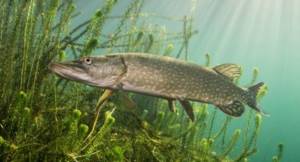
Spawning coincides in time with the highest rise of low waters, and on rivers it is often earlier - with the appearance of the edges, before ice drift. There is a popular proverb: “The pike breaks the ice with its tail.” This refers specifically to the time of its spawning. Spawns in shallow bays, often on flooded coastal grass. At this time, the migration of waterfowl begins. While the birds are swimming, the spawned pike eggs stick to their paws, and after further flight and landing on other bodies of water, they are cleaned off by algae and water as they move. This is how waterfowl participate in the spread of pike throughout freshwater bodies.
I must say that pike is a very valuable fish. Its presence in water bodies is necessary. She is a nurse and a reservoir ameliorator. It is the pike, lurking in ambush for the time being, that selects weak and low-value, sick fish for attack, contributing to the selection of the best. In contrast to the perch, the pike does not continue to chase a strong, healthy fish that escapes its throw; it returns to the ambush again. Its desire to attack mainly weak fish is based on giving the spinners oscillations (instead of rotation), as well as guiding them with ledges. Where pike are caught and destroyed too intensively (which often happens in suburban reservoirs), a breeding ground for various mass fish diseases is certainly created (for example, remenets - a parasitic tapeworm, sometimes mistakenly called tapeworm). In the case of heavy pike fishing, the amount of infected fish can reach 40–60%.
On rivers in spring and summer, pike stay close to riffles overgrown with algae or littered with large stones. She avoids bare, sandy rifts and places. The largest pikes can hide at the entrances and exits of deep pools, but do not stay in the very depths. They inhabit places with weak and moderate currents, often next to the swift water, always in ambush behind some kind of shelter - snags, bushes, stones, driftwood, etc. They do not linger in fast, shallow streams and rivers with spring, cold water.
In lakes and reservoirs it occupies places near accumulations of small things, often near the edge of algae. Can change places when moving small items. In general, pike are very constant in their choice of stopping places; If you catch one from such a place, it will soon (in 4–6 days) be occupied by another.
In autumn, when the water gets colder, the pike moves to the depths. Following small things, it always concentrates near the shore, protected from the wind, or at depths in large bodies of water. After the first frost appears after the roach off the coast, along the line of drooping algae.
With the flowering of bird cherry, the post-spawning feeding of pike begins. At this time, she grabs the bait throughout the daylight hours.
In summer, pike bite in clear weather only at dawn, while the surface of the water seems dark leaden. In cloudy weather, the bite is better and can last up to 10–11 o’clock and starts again at 18–19 o’clock. The main sign of a possible bite is the dark, leaden color of the water surface. If it shines so much that your eyes squint, it means that it is difficult to catch a pike, only possible in the windows of algae. In general, fishing among algae is most successful in summer. Before a thunderstorm, when clouds begin to cover the sky, and during a thunderstorm, pikes have a hunger that ends when the thunderstorm subsides. In autumn, with the coloring of the leaves, a long and steady pike bite begins, which continues until the start of freeze-up.
Pike almost always rushes from ambush, but if there is a lack of food, it can move secretly in search of prey. It grabs the bait crosswise and squeezes it with its teeth, holding it until the poison of the teeth takes effect, paralyzing the fish. Then it turns the bait over and swallows it from the head. Starting to swallow, she moves off, heading to her ambush. This is the moment to strike. You cannot hook when the pike, having grabbed the bait, moves by inertia (the first throw) or stands, squeezing it in its teeth. But if it starts moving after stopping, then you need to hook it and immediately start fishing, and drag the fish without delay.
Pike is treacherous. Once hooked, she strongly resists and tries in every possible way to free herself. Often jumps out of the water and, shaking its head, tries to throw the hooks out of its mouth. It can even rush towards the fisherman and so quickly that you don’t always have time to reel in or choose the line. And the pike, having weakened the line, can go into cover and tangle the tackle there.
A lot of different gear is used when fishing for pike, and the tactics are varied, but each is good for its season. Only a float rod, a jig and a spinning rod are suitable for the entire open water season. The circles, bottom and path are suitable only until algae grows and in late autumn, when the vegetation dies down. For fishing from ice, winter lures and vertical lures are used.
To catch pike with a spinning rod, use a variety of spoons and rigs to carry dead fish. You just need to remember that each spinner requires its own pace of retrieve to play with it, so it’s better to first fish with one or two types of spinners, gradually mastering others. The best bait for the tackle is considered to be bleak and gudgeon. Pike and frog take, but only during periods of famine. Slowly moving the spinner or rig near the bottom is the key to success in pike fishing. The pace of the drive should be interspersed with short-term accelerations and a stop of the drive after them for 1–2 s. Fishing with a rig with dead fish is more successful than with a spoon.
The same rules are also required for fishing on the track, which is most successful in the fall, after the pikes retreat to the depths. Fishing with circles is good all the time while the water is open, but it is difficult with the growth of algae, especially difficult in strong winds, and impossible in large bodies of water.
The floating of circles, the so-called drowning, is organized along the edge of the seaweed. Sometimes the mugs are anchored with a heavy sinker, and the live bait is raised somewhat above the bottom.
Fishing with a float rod along the windows of algae, where live bait is lowered, is usually successful. You need to move from one window to another along the shore, stopping at each for 1–3 minutes. Sometimes it is useful to move 10–15 m from the shore, leaving live bait in the window for 3–5 minutes. On rivers with a float rod, you also often have to move around, exploring suitable places.
A zherlitsa is a tackle specially invented for catching pikes, and fishing with it requires no explanation.
It should be noted that the correct opinion is that the tee is unsuitable for fishing with live bait. Often a pike, having grabbed the bait, gets stuck on one of the hooks and spits out the bait. It is much better to use doubles, positioning them so that the stings are pressed to the body of the baitfish. This is very important for fishing with live bait, as well as with rigs with dead fish.
In winter, pike are most successfully caught on first ice, and in spring - when melt water begins to penetrate under the ice. The best bite is in non-frosty, cloudy, windless weather.
Sheer trolling is an active search for pike that requires drilling many holes. It is most common in the first ice.
The game is smooth with a slow rise of the spoon and a pause of 2-3 seconds, which is especially important when fishing on lakes and reservoirs. On rivers the game can be more energetic. Winter girders are an equally active method of fishing if the angler does not stop searching for pikes after the first placement, but moves the girders, changing installation locations every 30–40 minutes. Pike do not disperse throughout the entire reservoir in winter, as they do in summer. They gather near places where there is a lot of small change. If you can find such a place, you can complete your catch quota in one to two hours. In winter, the best pike bite is at dawn and evening twilight. However, there are reservoirs where she takes bait from 13:00 to 15:00.
In open water, pike should be caught with a landing net; for very large ones, a hook must be used. If it happens that there is no landing net and hook, then you can take it by hand. This must be done quickly. You should take the fish near the back of the head - closer to the body, placing your hand from the side of the tail. Having grabbed it, you must immediately squeeze it with all your strength, slightly pressing the gill covers inward, and then throw it in one motion into the boat, onto the shore or raft. You cannot take a pike under the gills - there are spikes of teeth behind them. Very large pikes have to be handled with both hands.
For pike fishing, lines with a diameter of 0.4–0.5 mm are used most often without metal leashes, which remain only on the girder and circles.
White hooks No. 8–10 with a long shank. The local name for pike is shupak. Share on social networks:

